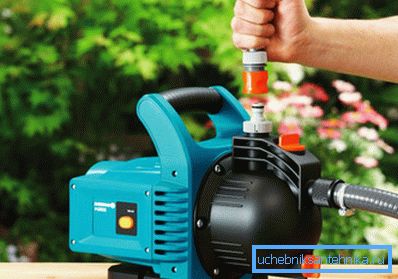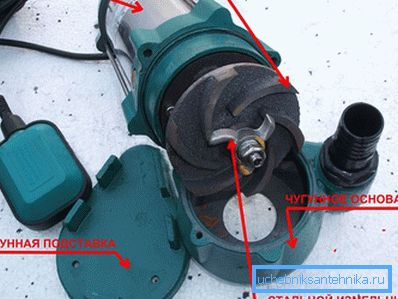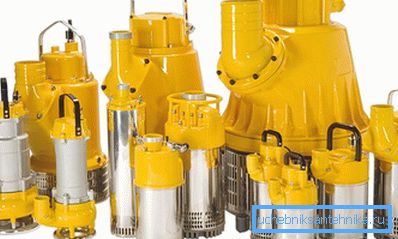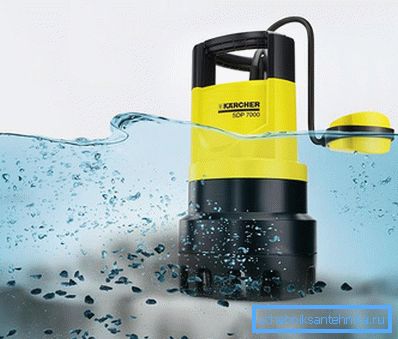How to choose a drainage pump
Excess water on the site can bring a lot of trouble. For its removal use the drainage system. But it is often necessary to pump out water from various reservoirs, for example, inspection or filter wells. For these purposes, use a special unit - drainage pump. Such equipment can even cope with liquids that contain solid contaminants (sand and various debris). And how to choose a drainage pump, will be discussed in this article.
Classification

To determine which pump is suitable for your case, you should understand their classification. Such units can be divided according to various criteria. We describe the most significant.
According to the installation site, the units are divided into:
- Surface. The pump itself is on the surface, the suction takes place with a special hose.
- Semi-submersible. The housing itself is on the surface, only the suction device is immersed in the liquid.
- Submersible. Fully immersed in the pumped liquid.
According to the material used for the production of drainage pumps are divided into:
- Completely made of plastic. Such units have the lowest price, but such cheapness affects the service life. All plastic pumps have the shortest service life.
- Plastic with metal working mechanisms.
- Made of steel and cast iron. These pumps have the longest service life. In addition, they are not afraid of mechanical stress.
Most household drainage pumps are paddle type. In this case, the blades themselves can be made of technopolymer material or stainless steel. The first option is not afraid of corrosion and resistant to wear. The blades of stainless steel surpass their polymer counterparts in technical characteristics, but the cost of such products is higher.

In addition, many drainage pumps are equipped with additional equipment. So, the majority of submersible units have a special device that crushes the pollutants in the pumped liquid. This allows you to extend the life of the unit.
Almost all models are equipped with floats. They help to control the operation of the unit. When a liquid reaches a certain level, the float turns off the pump, thereby preventing it from working “idle”.
Selection rules

There are many pumps on the market today that can be used for dirty water. You can find both domestic and imported devices. Therefore, to choose a suitable for the price and functionality of the pump is not difficult.
When choosing a model, first of all it is necessary to pay attention to two main parameters:
- performance;
- water pressure.
The first indicator determines the volume of fluid that will be pumped in an hour. Here the choice depends entirely on your needs. The water pressure will be responsible for the distance to which the fluid must be diverted and for the height of the rise.
If you need to pump out water with a high content of solid particles, it is better to purchase a device with a grinder.
If you choose between the types of drainage pumps (submersible, surface or semi-submersible), then everything will depend on the place of its use. If necessary, the constant pumping of water from the well is better to buy a submersible unit. Such a pump has sufficient power, but low mobility. When using the device in different places, it is better to purchase a surface pump. It is easy to transfer to the right place and connect.
Overview

Manufacturers produce many models of such devices, before choosing it is worth looking at a review of models. We name only a few of the most popular pumps:
- Pedrollo TOP Vortex - Italian submersible pump. The case and some parts are made of special technopolymer, which significantly increases the resistance to aggressive media. Able to pump up to 10 m3 at an hour at the created water column in 7 meters. Easily cope with solid fractions up to 20 mm. The cost of the model is from 8000 rubles.
- SDP 7000 - submersible pump from the famous German manufacturer "Kärcher". Easily cope with 7000 liters per hour. Creates a water pressure to 6 meters. Equipped with a float sensor and a filter that cuts off particles larger than 20 mm. The cost of this model starts from 3500 rubles.
- Domestic development - pump "Dzhileks". The power of the unit is 880 watts, this is enough to pump out water from a depth of up to 8 meters. Capacity up to 12 m3 per hour, while the effluent may contain solid particles with fractions up to 30 mm. The cost of the pump starts from 3500 rubles.
- Japanese pump Makita PF 1010. Copes with solid fractions up to 35 mm, while pumping water from a 5-meter depth. The cost of the device from 5000 rubles.
Information about the price of pumps is given for comparison and after some time can be changed by the manufacturer. The real value of the goods must be found on the official website of the manufacturer or trading organization.
Video
Watch the introductory video on the types of drainage pumps: